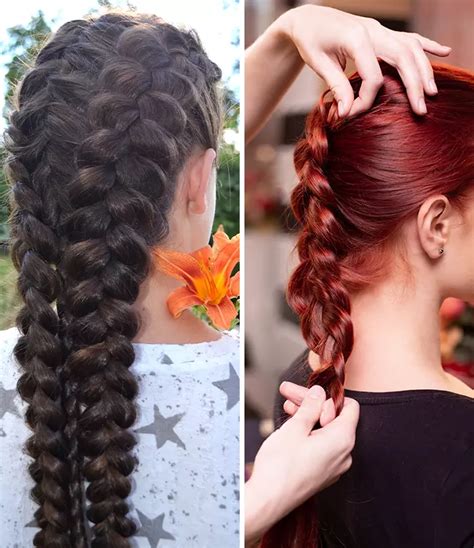Braids have been a popular hairstyle for centuries, and there are many different types to choose from. Two of the most common types are Dutch braids and French braids. While they may look similar, there are a few key differences between the two.

Dutch Braid
- Weaving Technique: The main difference between a Dutch braid and a French braid is the way the hair is woven. In a Dutch braid, the hair is crossed over the top of the head, while in a French braid, the hair is crossed under. This creates a different look, with Dutch braids being tighter and more textured than French braids.
- Appearance: Dutch braids are typically thicker and more prominent than French braids. They also have a more defined, three-dimensional look.
- Use: Dutch braids are a good choice for holding hair back from the face, or for creating a more formal look. They can also be used to add volume and texture to hair.
- Difficulty: Dutch braids are considered to be more difficult to master than French braids, as they require more precision and coordination.
- Popularity: Dutch braids are becoming increasingly popular, especially among athletes and fashionistas.
French Braid
- Weaving Technique: In a French braid, the hair is crossed under the head, while in a Dutch braid, the hair is crossed over the top. This creates a different look, with French braids being looser and more flowing than Dutch braids.
- Appearance: French braids are typically thinner and less prominent than Dutch braids. They also have a more delicate, feminine look.
- Use: French braids are a good choice for everyday wear, or for creating a more casual look. They can also be used to add length and volume to hair.
- Difficulty: French braids are relatively easy to learn, making them a good choice for beginners.
- Popularity: French braids have been a popular hairstyle for centuries, and they continue to be a favorite among women of all ages.
Which Braid Is Right For You?
The best way to decide which braid is right for you is to experiment. Try both Dutch and French braids and see which one you prefer. Keep in mind that the type of braid you choose will depend on your hair type, the occasion, and your personal style.
Table 1: Comparison of Dutch and French Braids
| Feature | Dutch Braid | French Braid |
|---|---|---|
| Weaving Technique | Hair crossed over the top of the head | Hair crossed under the head |
| Appearance | Thick, tight, and textured | Thin, loose, and flowing |
| Use | Formal occasions, holding hair back from the face, adding volume and texture | Everyday wear, adding length and volume |
| Difficulty | More difficult | Easier |
Table 2: Pros and Cons of Dutch Braids
| Pros | Cons |
|---|---|
| Thicker and more prominent | Can be more difficult to master |
| Tighter and more textured | Not as versatile as French braids |
| Good for holding hair back or creating a formal look | Not as easy to wear with hair down |
Table 3: Pros and Cons of French Braids
| Pros | Cons |
|---|---|
| Thinner and less prominent | Can be too loose and flowing for some occasions |
| Looser and more flowing | Not as good for holding hair back |
| Versatile and can be worn with hair up or down | Can be more difficult to master than Dutch braids |
Table 4: Expert Tips for Braiding Hair
- Use a little bit of hairspray or mousse to help keep hair in place.
- Start with small sections of hair and gradually add more hair as you braid.
- Keep the tension even throughout the braid.
- Don’t be afraid to experiment with different braiding techniques.
- Practice makes perfect!
Conclusion
Dutch and French braids are both beautiful and versatile hairstyles. By understanding the differences between the two, you can choose the right braid for any occasion. With a little practice, you can master both braiding techniques and create stunning hairstyles that will turn heads.
